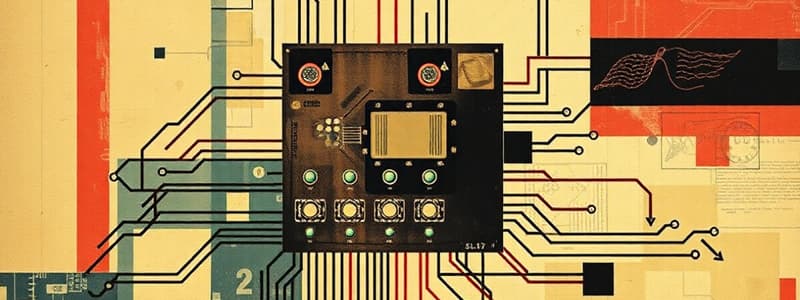Podcast
Questions and Answers
Which logic gate outputs true only if at least one input is true?
Which logic gate outputs true only if at least one input is true?
- XNOR Gate
- OR Gate (correct)
- AND Gate
- NAND Gate
What is the primary function of a NOT gate?
What is the primary function of a NOT gate?
- Maintains a binary state indefinitely
- Outputs the same value as the input
- Combines multiple inputs to produce a single output
- Outputs the inverse of the input (correct)
Which flip-flop has the ability to toggle its output based on its inputs without invalid states?
Which flip-flop has the ability to toggle its output based on its inputs without invalid states?
- T Flip-flop
- D Flip-flop
- SR Flip-flop
- JK Flip-flop (correct)
In what form is the state change of flip-flops triggered?
In what form is the state change of flip-flops triggered?
Which type of logic gate will output false only when all inputs are true?
Which type of logic gate will output false only when all inputs are true?
What is the output behavior of a T flip-flop when the T input is high?
What is the output behavior of a T flip-flop when the T input is high?
What is a unique characteristic of an XOR gate?
What is a unique characteristic of an XOR gate?
What is represented in the characteristic tables of flip-flops?
What is represented in the characteristic tables of flip-flops?
Flashcards are hidden until you start studying
Study Notes
Digital Electronics Study Notes
Logic Gates
-
Definition: Basic building blocks of digital circuits that perform logical operations on one or more binary inputs to produce a single output.
-
Types of Logic Gates:
- AND Gate: Outputs true (1) only if all inputs are true (1).
- OR Gate: Outputs true (1) if at least one input is true (1).
- NOT Gate: Outputs the inverse of the input (1 becomes 0 and vice versa).
- NAND Gate: Outputs false (0) only if all inputs are true (1); the opposite of AND.
- NOR Gate: Outputs true (1) only if all inputs are false (0); the opposite of OR.
- XOR Gate: Outputs true (1) if exactly one input is true (1); exclusive OR.
- XNOR Gate: Outputs true (1) if both inputs are the same (either both true or both false).
-
Symbol Representation: Each gate has a unique symbol used in circuit diagrams.
-
Truth Tables: Used to define the output of a gate for all possible input combinations.
-
Applications: Used in arithmetic operations, data processing, and control systems.
Flip-flops
-
Definition: Basic memory elements in digital electronics used to store binary data; can maintain a state indefinitely until changed by an input signal.
-
Types of Flip-flops:
- SR Flip-flop: Set-Reset flip-flop; has two inputs (S and R) and two outputs (Q and Q'). It sets or resets the output based on the input conditions.
- JK Flip-flop: Similar to SR but eliminates invalid states; has two inputs (J and K) and can toggle its output.
- D Flip-flop: Data flip-flop; has one data input (D) and outputs the value of D on a clock edge.
- T Flip-flop: Toggle flip-flop; changes its output state on each clock pulse if the T input is high.
-
Operation:
- Flip-flops are edge-triggered, meaning they change states on a specific edge of the clock signal (rising or falling).
-
Applications: Used in data storage, shift registers, counters, and memory devices.
-
Timing Diagrams: Visual representation of the timing relationship between input and output signals of flip-flops.
-
Characteristic Tables: Define the relationship between inputs and outputs for each type of flip-flop.
Logic Gates
- Basic building blocks for digital circuits, performing logical operations on binary inputs to produce a single output.
- AND Gate: Outputs true (1) only when all input values are true (1).
- OR Gate: Outputs true (1) if at least one input is true (1).
- NOT Gate: Outputs the inverse of the input; 1 becomes 0 and vice versa.
- NAND Gate: Outputs false (0) only when all inputs are true (1), serving as the inverse of the AND gate.
- NOR Gate: Outputs true (1) only when all inputs are false (0), serving as the inverse of the OR gate.
- XOR Gate: Outputs true (1) if exactly one input is true (1); also known as exclusive OR.
- XNOR Gate: Outputs true (1) when both inputs are identical (both true or both false).
- Each gate is represented with a unique symbol in circuit diagrams.
- Truth tables map out the output of each gate for every possible combination of inputs.
- Applications of logic gates include arithmetic operations, data processing, and control systems.
Flip-flops
- Fundamental memory elements used to store binary data, capable of maintaining state indefinitely until altered by an input signal.
- SR Flip-flop: Comprises Set and Reset inputs (S and R) with corresponding outputs (Q and Q'); allows setting or resetting output based on conditions.
- JK Flip-flop: Designed to eliminate invalid states; has J and K inputs, capable of toggling its output.
- D Flip-flop: Stores data with a single input (D) and outputs the value at a clock edge.
- T Flip-flop: Changes output state with each clock pulse when the T input is high.
- Flip-flops operate as edge-triggered devices, meaning they switch states based on the edge of the clock signal (rising or falling).
- Commonly utilized for data storage, in shift registers, counters, and memory devices.
- Timing diagrams illustrate the synchronization between input and output signals of flip-flops.
- Characteristic tables clarify relationships between inputs and outputs for different types of flip-flops.
Studying That Suits You
Use AI to generate personalized quizzes and flashcards to suit your learning preferences.




